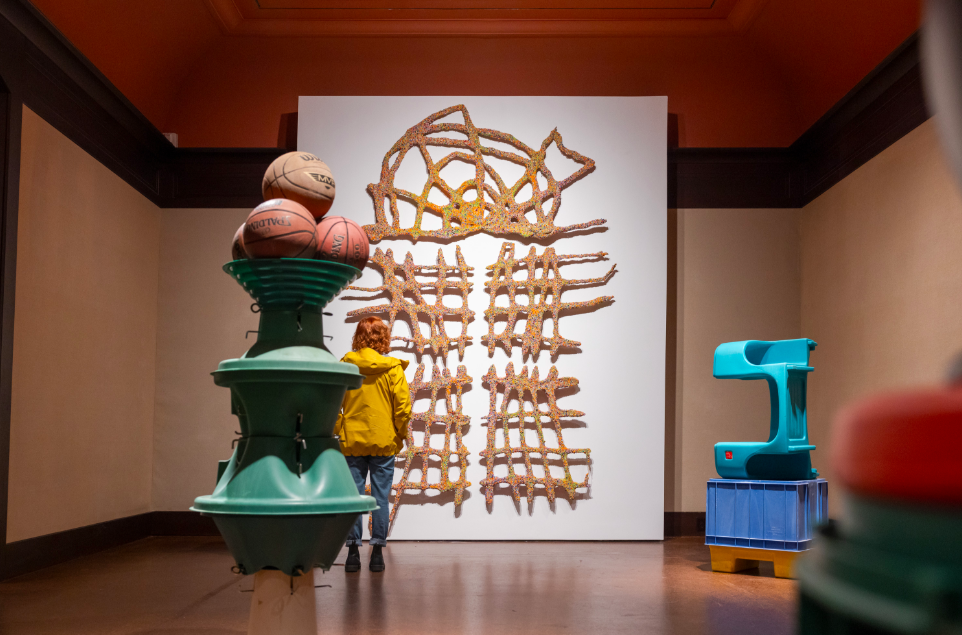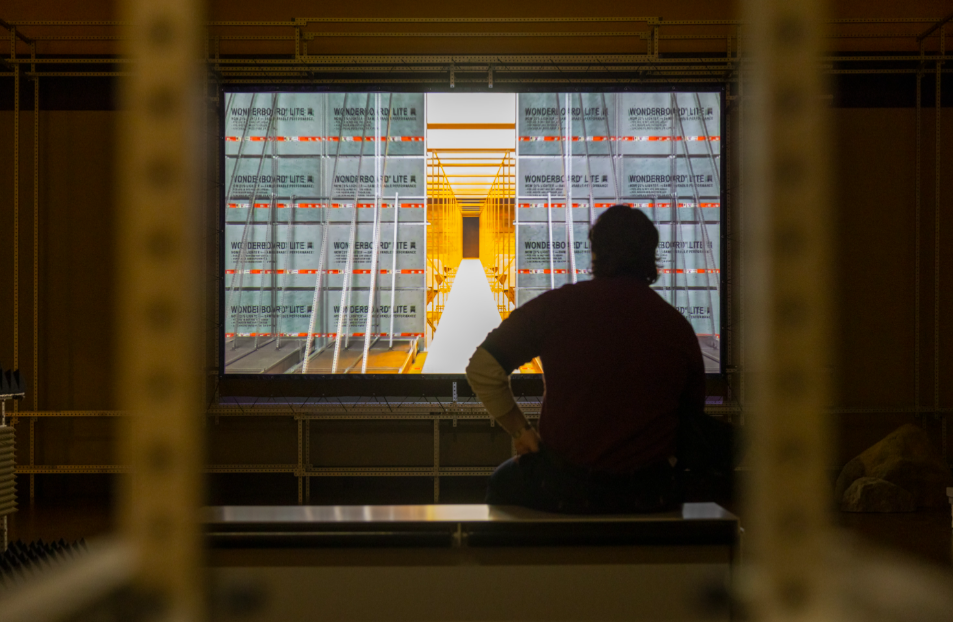by Zach Hunley / photo by Chris Uhren
Plastic: what is it good for? Unfortunately, way too much. No one material embodies the twentieth and twenty-first centuries as singularly as the stuff, and perhaps no one material more alarmingly poses an existential threat than our dependence and material addiction to it. That it has allowed us to make positive advances for our existence is undeniable. Yet, we consume plastic at a rate categorically at odds with the longevity of humanity. Where is the balance? Is there one? Coming to the Carnegie Museum of Art from last year’s 18th Venice Biennale of Architecture, Everlasting Plastics seeks to illuminate this complicated and seemingly unbreakable bond.
Norman Teague’s Re+Prise occupies the primary corridor of the CMOA’s Heinz Architectural Center, greeting visitors with a cascading platform of colorful, sculptural vessels made of extruded plastics. Gloopy and vibrant, these playful forms serve to demonstrate the ways in which discarded plastic consumables—the exuberant and warm orange of a detergent jug, the richly saturated blue of a bottle of bleach—can be refracted through a diasporic lens. The melting down of these quotidian vessels dematerializes both their recognizability and function in a system of American consumerism, reconstituting their materiality within the frame of West African weaving techniques.
Working with plastic waste in this culturally engaged manner also adds a conceptual layer to Teague’s work—one which speaks to the notion of externalities, the consequences industrial production brings to communities and individuals not considered within a monetary system of value. Plastic, at every stage in its lifecycle, poses serious consequences. Neighboring Teague’s vessels, Ang Li’s Externalities makes the gravity of our plastic consumption impossible to ignore.
Comprised of a starkly white wire cage, Li’s work is a sort of vessel of its own, packed and stacked with fragments of expanded polystyrene foam (EPS). Popularized in the 1930s for its properties as a domestic insulator, Li contrasts the volumetric physicality of the nearly weightless material with the heavy and imposing reality presented by its now generational overconsumption. Accompanying archival photographs of individuals triumphantly posing alongside massive slabs of EPS create a humorous and abrupt contrast to the mood created by the the architectural installation. The scrolling LED panel mounted to the top corner of the gabion constitutes the most overtly didactic component of the entire exhibition, with line after line of text enumerating the horrific externalities associated with past and present EPS production and consumption—pretty bleak.
This tiny addition to Li’s installation could be easily overlooked by many, as the consequences of our plastic obsession have been historically, but in the context of the exhibition it highlights one of my chief frustrations with the show: its imbalance between saying something concrete about plastic and reveling in its material properties and deployment within artistic craft. Everlasting Plastics refuses to steak any singular claim about plastic. Work such as Li’s makes it clear that the material is fraught with negative consequences, but it also dares us to see ourselves in the medium, to reckon with our own plasticity.
Nowhere is this unnerving line drawn more clearly in the exhibition than Lauren Yeager’s post-minimal stacked sculptures of plastic objects collectively titled Longevity. There is a certain excitement and novelty in seeing everyday plastic objects inventively arranged in this way, and there is certainly something to be said about the manner in which our associated memories and feelings cling to the them.
I see the yellow of Little Tikes chairs and I think about my childhood—the plastic becomes an infallible artifact of my upbringing; I see the stack of coolers and recall time spent camping “away” from urban comforts—the plastic becomes a hollow vessel of time and experience compounded. There’s something melancholic and stoic about seeing these pieces; plastic revealed as a cold, immortal shell of insurmountable permanence. They feel dead, yet here they are somehow still speaking.
Yeager’s plastic totems share space with three of Simon Anton’s four linear wall constructions collectively titled This Will Kill _ That. Comprised of steel supports consumed by a confetti of highly textural recycled plastics, I appreciate their material construction more than I was able to grasp the institutional critiques Anton tries to articulate. Perhaps these works would have been more effective had they been displayed together; they felt distracting in the context of Yeager’s sculptures.

Xavi Aguirre’s video installation PROOFING: Resistant and Ready is the most disparate component of this exhibition, and also its weakest component. Severed from the rest of the galleries by heavy plastic curtains (a welcomed bit of tactility), the space is too dimly lit to appreciate any of the architectural elements comprising the installation. I experienced very few elements prescribed in the accompanying didactic, and, apart from the well mixed soundtrack by composer Ash Fure and the wonderful acoustics in the space, found the work to frustratingly opaque.

With work by six artists, Everlasting Plastics gestures towards several of the seemingly infinite concerns posed by our relationship to plastic and plasticity. It is effective in conveying some of these points, but I remain unsure as to what I should feel or how I should think. I can say, however, that, after spending time with the work in this exhibition, the precise nature of our kinship with plastic, nebulous and elusive as it may be, will remain as much a reflection of ourselves and our time as the chemicals that bind it.
Everlasting Plastics is on view at the Carnegie Museum of Art’s Heinz Architectural Center through July 21.
Zach Hunley (they/he) is a Pittsburgh-based modern and contemporary art historian, arts writer, critic, photographer, collector of things, and proud father to a senior guinea pig. With a keen observational eye, they use their writing as a means to refract their deep appreciation for formal aesthetics through a socially engaged lens. They hold an M.A. in Art History from West Virginia University, Morgantown, WV.
